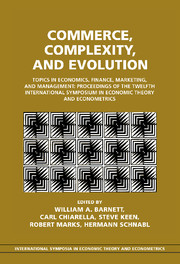 Commerce, Complexity, and Evolution
Commerce, Complexity, and Evolution Published online by Cambridge University Press: 05 December 2011
It is usually assumed in economic theories that a consumer's utility depends only on his or her own consumption: A person's preference is not affected by other people's behavior. However, this is not always the case; to buy a suit, an antique, or a computer, one may consider how many other people have the same product. If a person's optimal decision depends on the number of those who make the same decision, it is said that there are behavioral dependencies resulting from network externalities. In this chapter we develop a cellular-automata (CA) model to describe the dynamics of markets with network externalities.
Behavioral dependence resulting from network externalities is not a new subject in economics. Not a few theoretical and empirical studies have been done about it among consumers since Liebenstein (1948) introduced the concept of bandwagon and snob effects; among recent related studies are those of Choi (1994), Church and King (1993), Curien and Gensollen (1990), Ducan (1990), Kesteloot (1992), and Liebowitz and Margolis (1994). Unfortunately, the conventional equilibrium analysis of markets with network externalities (Pyndyck and Rubinfeld 1990) seems to inappropriately express the dynamic process of such markets. Recent studies of Bikhchandani et al. (1992), Arthur and Lane (1993), Narduzzio and Warglien (1996), and Lane and Vescovini (1996) are more dynamical and clarify some interesting patterns of diffusion processes.
Nevertheless these mathematical models presume that behavioral dependence is sequential: They assume that the kth person observes all or some of his or her k – 1 preceding persons but not in reverse.
To save this book to your Kindle, first ensure [email protected] is added to your Approved Personal Document E-mail List under your Personal Document Settings on the Manage Your Content and Devices page of your Amazon account. Then enter the ‘name’ part of your Kindle email address below. Find out more about saving to your Kindle.
Note you can select to save to either the @free.kindle.com or @kindle.com variations. ‘@free.kindle.com’ emails are free but can only be saved to your device when it is connected to wi-fi. ‘@kindle.com’ emails can be delivered even when you are not connected to wi-fi, but note that service fees apply.
Find out more about the Kindle Personal Document Service.
To save content items to your account, please confirm that you agree to abide by our usage policies. If this is the first time you use this feature, you will be asked to authorise Cambridge Core to connect with your account. Find out more about saving content to Dropbox.
To save content items to your account, please confirm that you agree to abide by our usage policies. If this is the first time you use this feature, you will be asked to authorise Cambridge Core to connect with your account. Find out more about saving content to Google Drive.